- This article is about the World of Avatar. For the bending art, see earthbending.
Earth, also known as the World of Avatar or the Mortal World, is the world divided into the four nations and home to a multitude of species. World is a common name for the sum of human civilization, specifically human experience, history, or the human condition in general. The World of Avatar plays home to benders and hundreds of chimerical creatures. Earth is surrounded by a vast void known as outer space.
Geography
- Main article: Geography of the World of Avatar
The World of Avatar is divided into four separate nations: the Water Tribes, the Earth Kingdom, the Fire Nation, and the Air Nomads.[1] At the end of the Hundred Year War, Fire Lord Zuko and Avatar Aang transformed the Fire Nation colonies located in the Earth Kingdom into a fifth independent realm, the United Republic of Nations. Each location has unique geographical layouts, civilizations, climates, and demography, and each one has a diverse range of landforms.
Air Nomads
- Main article: Air Nomads
The Air Nomads were a civilization composed of people who practiced the art of airbending. While nomadic, Air Nomads did inhabit four major air temples, each built on remote locations, only easily reachable with sky bison. The Air Nomads were a highly spiritual group of people. Being that their economy was based solely on agriculture, they were the smallest of the four nations, but all of their members were benders.
Water Tribe
- Main article: Water Tribe
The Water Tribe is a collective term for people, some of whom practice the art of waterbending, who follow a government system in the form of a tribal chiefdom. Although members of the Water Tribe typically inhabit the polar regions, the North Pole and the South Pole, there is a small population of waterbenders who inhabit the Foggy Swamp in Earth Kingdom territory.[2] The two main tribes are the Northern Water Tribe at the North Pole and the Southern Water Tribe at the South Pole.
Earth Kingdom
- Main article: Earth Kingdom
The Earth Kingdom is a massive continent led by the Earth King and is home to people who practice the art of earthbending. Being the largest of the four nations, it is ethnically diverse with a variance of customs and cultural traditions. The people of the Earth Kingdom are strong and persistent. The geography of the Earth Kingdom varies tremendously, ranging from wooded forests to blazing deserts, mountainous terrain, and grassy plains.
Fire Nation
- Main article: Fire Nation
The Fire Nation is home to people who practice the art of firebending and is an absolute monarchy led by the Fire Lord. Being composed of several major islands and located on the equator, the nation is considered to be an archipelago. Its economy is the largest and most powerful in the world with a strong industrial sector and advanced technological developments. The climate is normally humid and warm which allows for a diversity of flora and fauna to thrive.
United Republic of Nations
- Main article: United Republic of Nations
After the Hundred Year War was over, the Fire Nation colonies in the Earth Kingdom were granted independence as a fifth nation. Avatar Aang envisioned it as a place where people from all cultures, benders and nonbenders, could live together in peace. As such, its culture is an amalgamation of the other four nations' cultural identities. It is run from its capital, Republic City, by a president. Prior to 171 AG, the nation was led by five members of an assembly, called the United Republic Council, comprised of a single representative from each nation, except for the Water Tribe which had a separate representative for its northern and southern divisions.
Bending arts
- Main article: Bending arts
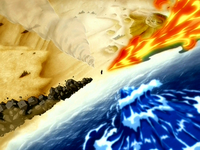
Avatar Roku bending all four elements simultaneously.
One of the most unique features about the World of Avatar is the ability to bend the elements. The bending techniques, waterbending, earthbending, firebending, and airbending, correspond with the Water Tribe, Earth Kingdom, Fire Nation, and Air Nomads, respectively. Each nation has its bending masters, who train the younger benders how to use their abilities and pass the culture on through the generations. Bending abilities are significant to all aspects of life in the World of Avatar. A more aberrant and perilous technique is the ancient art of energybending, which predates the other four arts, as well as the arrival of the Avatar and the formation of the four nations. It involves bending the life energy within another being.[3]
Avatar
- Main article: Avatar
The Avatar is the holder of the Avatar Spirit and the only physical being with the ability to learn all four bending disciplines. The Avatar acts as the medium between the physical world and the Spirit World.[4] It is considered the Avatar's duty to master all four bending disciplines and use such power to keep balance among the four nations. With the death of the Avatar, the spirit is reborn into the following nation, dictated by the cyclic order: water, earth, fire, air. The Avatar is highly revered by people of all kinds and each nation has its own temple devoted solely to the Avatar.[1]
Flora and fauna
- Main article: Flora in the World of Avatar
- Main article: Fauna in the World of Avatar
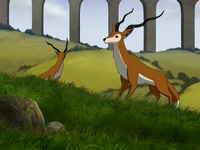
Fox antelopes, a common example of the chimerical animals in the Avatar World.
Most of the fauna in the World of Avatar are chimeras. There are some notable non-hybrid creatures, however. Flora in the World of Avatar varies greatly between the four nations, depending on the weather and climate. While the desolate, frozen landscapes of the poles do not allow for much flora to thrive, warm, moist landscapes in the Earth Kingdom allow for a diversity of plant life to survive. Fauna is used primarily as a source of food and transport. They are also used as a source of clothing, and some animals are even an icon for religious beliefs, in terms of the Spirit World. Flora is utilized for decorations, gifts, and tea.[1]
Occupations
- Main article: Occupations in the World of Avatar
There are a diversity of occupations in the World of Avatar, most of which are associated with the fulfillment of the basic needs of citizens. Certain places, such as the Ba Sing Se University,[5] specialize in training and preparing citizens in the handling and developing of professions. While there are only a select few careers to pursue in the Air Nomad civilization, a wide range of occupations is open to people in the Earth Kingdom and Fire Nation due to their large economies and numerous industries.[1]
Cuisine
- Main article: Cuisine in the World of Avatar
Cuisine in the World of Avatar can be divided into roughly four traditions, which follow the division of the four nations, however regional variation inside each nation can be large, particularly in the Earth Kingdom.[1]
Economy
- Main article: Economy in the World of Avatar
All four nations in the World of Avatar have, or previously had, developed economic systems. The Earth Kingdom and the Fire Nation have developed sophisticated and advanced economic systems to facilitate and supplement their daily life, while the Water Tribes and Air Nomads have relatively small systems based on subsistence and made less impact on their surroundings.[1]
Currency
- Main article: Currency
The currency of the four nations is based on precious metals and quite possibly on a gold standard. All nations that use currency seem to use the same metals though fashion them in different shapes and sizes. The coins of the Earth Kingdom are fashioned in the shape of the national emblem, though gold pieces have four notches on the edge, giving them a flower-like shape, whereas those of the Fire Nation are fashioned with their national emblem situated in the middle. Water Tribe money is somewhat different. Their circular coins are colored white, surrounded by a blue circle and have a hole in the center. Most nations appear to use gold, silver, and copper pieces, with gold seemingly having the highest value.[1] The United Republic of Nations uses the yuan, denominations of which are available as both coins and paper bills.
Politics
- Main article: Politics in the World of Avatar
Politics and government in the World of Avatar are based around several political systems, each of which has its distinctive strengths and weaknesses. There are four broad types of political systems in the different nations, each with a distinctive character that corresponds with the associated element of that country. The Air Nomads had a theocracy led by four councils of monks or nuns,[6] the Water Tribe has a tribal system led by two separate chiefdoms in the North and South Poles, the Earth Kingdom has a confederate monarchy led by the Earth King, and the Fire Nation has an absolute monarchy led by the Fire Lord. Prior to 171 AG, the United Republic of Nations was led by the United Republic Council, with each member of the group representing one of the four nations, except for the Water Tribe which had two representatives; one for each main tribe. The United Republic is currently led by a president.
The Avatar acts independently of all nations, including the nation of his or her origin, in order to ensure that there is no unwanted bias in their international authority and peacekeeping.[1]
Society
- Main article: Society in the World of Avatar
Society is a major part of life in the World of Avatar. Social classes are usually based upon titles, wealth, power, and accomplishments. Although people are usually born into their social rank, there are some exceptions in which people can gain a higher position due to important service to royals. Society differs between nations, as the peaceful Air Nomads have nowhere near as complicated of a society as the Fire Nation or the Earth Kingdom.[1]
Military and weaponry
- Main article: Military ranks in the World of Avatar
- Main article: Weaponry in the World of Avatar
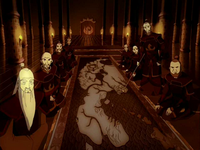
High-ranking members of the Fire Nation military.
Each nation, except for the Air Nomads,[7] has a distinct military system. The Military of the Fire Nation is the unified armed forces of the Fire Nation. It is the most powerful military force in the world and would have won the Hundred Year War if not for the intervention of Avatar Aang. The Military of the Earth Kingdom is the military organization responsible for the defense of the Earth Kingdom. It consists of an army, a navy and several special forces. It wields considerable power, having held off Fire Nation assaults for a century. The Military of the Water Tribe is a group of organizations protecting the Water Tribes. Chain of command is not very well defined. There is no overall military commander of the Water Tribe, command being divided between the North and South. It is clear however that the chiefs of the two tribes have the overall command of their respective tribal militia.
Military ranks are a system of hierarchical relationships employed to clearly define a chain of command within the military.[1]
Organizations
- Main article: Organizations in the World of Avatar
There are a multitude of organizations in the World of Avatar. They range from vigilante fighting groups to councils of elders dedicated to the peaceful rule of a nation. Organizations can vary from the high ranking Council of Five to smaller, non-political organizations such as the 5-7-5 Society.[1]
Education
- Main article: Education in the World of Avatar
In the World of Avatar, education seems to be an important topic. In the Fire Nation, for example, education plays a significant role in the daily lives of children, especially those of the Upper Class and the Royal Family.[7]
Culture
- Main article: Arts in the World of Avatar
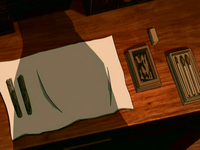
A complete set of writing implements.
Culture in the World of Avatar is very diverse in the four nations. This diversity ranges from visual arts, including portraits and paintings, to sacred dances and rituals. Writing and literature are an integral part of society. All four nations use a common system of characters borrowed from the Chinese system for daily purposes. Citizens primarily use writing for communication and literary purposes, but there are some who practice calligraphy.
Music is an important cultural aspect for all four nations. A variety of instruments are played, such as the tsungi horn and pipa, as well as a variety of songs. People from all the world enjoy playing music which serves as the prime source of entertainment. Songs in the World of Avatar range from ancient songs passed through generations or simply popular folk songs.
Cultural traditions vary depending on nation. For instance, the Water Tribes value a ritual known as ice dodging, a rite of passage for teenage boys. After the task is successfully completed, customary symbols, such as the Mark of the Brave, Mark of the Wise, and Mark of the Trusted, are given.[8] Individual regions within each nation also harbor varied cultural beliefs and customs.[1]
Architecture
- Main article: Architecture in the World of Avatar
Artistic and creative architecture is seen all throughout the World of Avatar ranging from the four nations, all using different materials to design buildings, such as metal, stone, and ice, which shows that constructions are composed of different material types depending on the climate of each nation and locally available equipment, in addition to the inheritance and cultural traditions of each region. Palaces, temples, houses, and small huts are examples of common architectural works.[1]
Fashion
- Main article: Fashion in the World of Avatar
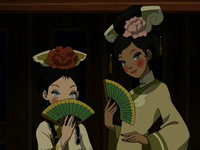
Katara and Toph wearing fashionable Earth Kingdom outfits.
People of the World of Avatar wear many different types of clothing and other accessories depending on the nation they hail from and their social status. The clothing ranges from very humble attire worn by the airbending monks to the elaborate robes worn by the Fire Lord. A notable fact of fashion in general is that each nation will wear the color that symbolizes their native element. The Air Nomads wear orange and yellow, the Water Tribes wear blue, the people of the Earth Kingdom wear yellow and green, and the people of the Fire Nation wear various hues of red, as well as black and gold.[1]
Sports and games
- Main article: Recreation in the World of Avatar
There are a large variety of sports and games in the World of Avatar for the recreation and entertainment of its people. These range from the physically demanding airbending sports and the excitement and dangers of ice dodging[8] to games like Pai Sho, which challenges the mind.
Many games of a given nation incorporate that nation's native bending element into the game. For example, airbending is utilized for airball and earthbending for earth soccer.[9] The most popular of these sports in the United Republic is pro-bending.
Science and technology
- Main article: Science in the World of Avatar
- Main article: Technology in the World of Avatar
Science was once of limited knowledge to the people in the World of Avatar. The most used, developed, and known science for many years was astronomy. The Fire Nation and the Earth Kingdom are the most developed nations in the field of scientific knowledge.[1]
Before the end of the Hundred Year War, technology varied greatly from nation to nation. The heavily industrialized Fire Nation was far more advanced than the other three nations, though the Earth Kingdom, albeit still pre-industrial, was much closer to the Fire Nation's capabilities than the peaceful and technologically unambitious Air Nomads or the Water Tribe, which only used primitive technologies in combination with airbending and waterbending, respectively, to achieve their goals. Some time after the Hundred Year War, many significant technological advances began to surface, which, by 170 AG, included the development of commercial motor vehicles, radios, skyscrapers, and cameras in Republic City.[10]
Spiritual beliefs
- Main article: Spiritual beliefs in the World of Avatar
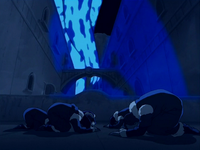
Northern Water Tribe villagers bowing to Koizilla.
Spiritual beliefs in the four nations are defined mostly through respecting various natural spirits, most of whom abide in the Spirit World. Beliefs differ greatly among the four nations; however, spirituality is an important role in everyday life. Spirituality is exercised in various ways depending on the nation and culture. For instance, Air Nomads were strict vegetarians, opposing the idea of eating all meat as a way to respect life. Life of the Water Tribe people was centered around two major spirits, those of the Moon and Ocean.[11] Various shrines and temples are common in the Earth Kingdom, many of which are dedicated to the Avatar. Some patrons do respect the spirits of nature, such as the Painted Lady[12] and Hei Bai, who had a statue built for him in the forest.[4]
Law and order
- Main article: Law and order in the World of Avatar
Law and order in the four nations varies from location to location. In the Fire Nation, the Fire Lord has total power, and officials around the land enforce his or her ideas. In the Earth Kingdom, law is written depending on each city or village, even though there is a leader of the land, called the Earth King. In the Northern and Southern Water Tribes, a chief creates the law of the land. In the United Republic, law is set by the United Republic Council and enforced by the Metalbending Police Force.